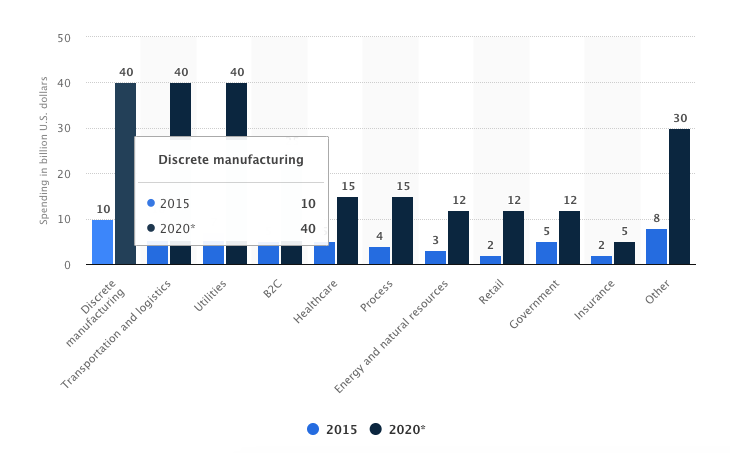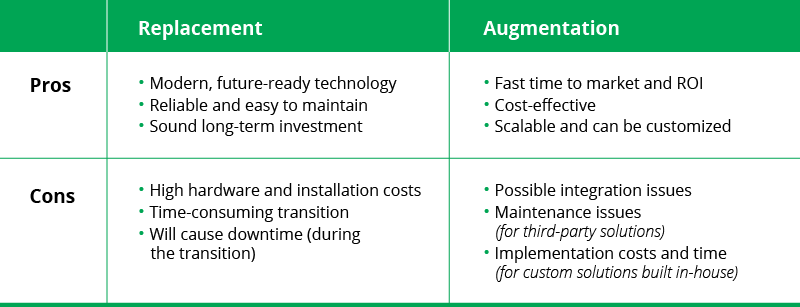Enterprise digital transformation is one of the major trends we’ve seen over the last couple of years. Along with cloud technologies and mobile solutions, the Internet of Things is an integral part of this process and one of the main transformation enablers.
As a result, many businesses are exploring the opportunities of industrial IoT to improve their performance and remain competitive in their niche.
Manufacturing has been one of the leaders in IoT adoption, along with transportation and utilities. Namely, 35% of businesses in the industry have been using smart sensors as of 2015. And this number is expected to reach 53% by 2020.
Yet, there’s one major challenge most manufacturers need to face before they can benefit from IoT adoption – the connectivity of old factory machines.
In this article, we will explore the opportunities and challenges for merging legacy equipment with Industrial Internet of Things and share some pro tips on how to do it.
The benefits of Industrial IoT in manufacturing
By 2020, the total spending will equal $40 billion (as compared to $10 billion back in 2015), according to Statista.

And there are some good reasons for that. Industrial IoT gives manufacturers a number of competitive advantages, including
- improved energy efficiency
- lower operating costs thanks to predictive maintenance
- improved equipment reliability and reduced downtime
- optimized performance due to production flow automation
- an additional source of data
As a result, IoT-enabled businesses gain a competitive edge and are typically more profitable.
There are also numerous potential use cases for the IIoT in manufacturing:
- remote asset management – tracking equipment condition, performance, potential damage and performance bottlenecks
- real-time, automated production flow optimization aimed at cutting waste
- instant product quality control at different stages of production flow
- employee safety – worker protection and accident prevention
- security and access control, e.g. biometric authentication systems
Yet, to implement those use cases and reap their benefits, manufacturers first of all need to build an ecosystem to support their IoT initiatives. This, in turn, often means integrating legacy machinery with the modern, cloud-based infrastructure.
Given the fact that the majority of factory equipment is at least 20 years old, this can pose a number of serious challenges for business owners.
How do you make legacy equipment wireless? Solutions for integrating old factory machines with IIoT
There are two main approaches to retrofitting legacy equipment for IIoT.
1. Replacement
Often referred to as “rip-and-replace”, this approach implies a complete substitution of the legacy machinery for modern, IoT-ready equipment.
Thanks to its numerous benefits, e.g. improved reliability and performance of new equipment, reduced waste generated from a lower power consumption and, its potential scalability, etc., this approach tends to be more viable in the long run.

Yet, there are also certain risks. Among the obvious disadvantages of replacing legacy equipment are the time and costs of such a replacement. As with the revolutionary digital transformation approach, when you throw away everything you have and start building new, future-ready business processes and tools from scratch, legacy machinery replacement can be extremely costly and time-consuming.
Moreover, replacing legacy equipment might eventually turn out to be wasteful too: if the new machines fail to deliver upon your expectations, it will be impossible to get any ROI.
2. Augmentation
The augmentation, aka “wrap-and-extend”, approach implies extending the equipment’s capabilities with third-party IoT connectivity tools. As a result, you can simply upgrade your legacy machinery merging them with various sensors, without the need to completely replace the old equipment.
Unlike replacing legacy equipment, augmentation is relatively affordable and fast. You don’t have to spend millions on new factory machines – IoT sensors are much cheaper.
Plus, the legacy equipment upgrade can be implemented through incremental changes, speeding up your time to market. You can simply integrate different sensors one by one to enable specific capabilities you need and add more of them later.
Speaking of a legacy equipment upgrade, there are two ways to go about that:
- Using off-the-shelf third-party tools, i.e. IoT connectivity solutions that are already available on the market (which can be customized to fit your needs).
- Building custom IoT solutions, specifically designed to meet your business needs, in-house.
But how do you choose the right strategy for merging legacy equipment with the industrial internet of things?
Here are the pros and cons of each approach at a glance.

On top of the above-listed pros and cons of each option, you should also take into account your specific business needs. Thus, you need to understand, first of all, the long/short-term goal you are trying to achieve with the help of IoT and the types of data you need to collect.
For example, if your objective is to implement quality control features within your production flow, you don’t have to replace the machines completely. You can simply augment the existing equipment with the corresponding sensors.
If you want to optimize the overall performance and cut waste, replacing old machines with the new connected machinery would be a more reasonable option in the long term.
The legacy equipment connectivity challenges
Regardless of the approach you opt for, you need to be aware of the main challenges when merging legacy equipment with Industrial Internet of Things. These include the following:
- Compatibility
Before you upgrade your hardware, make sure you understand the limitations and requirements set by your current software and infrastructure. In both cases, with the replacement, as well as with the augmentation, there’s a chance that you won’t be able to properly integrate the new IoT capabilities into your existing system.
- Cost vs ROI
While IoT capabilities can help you optimize your business operations and become more profitable in the long run, the implementation itself requires a significant upfront investment. The ROI, in its turn, might not be so obvious or may take some time to achieve.
For example, the long-term benefits of the data you source with the IoT sensors might be more significant than the direct savings you get by reducing energy consumption.

- Data security
Security challenges is one of the major roadblocks for IoT implementation across any industry, and manufacturing is no exception. Every connected device in your IoT network can serve as a point of entry for hackers and, as a result, lead to security breaches and data leaks.
A safer, more sustainable cloud alternative – edge computing, is where the solution to this problem may lie.
- Employee training
To use the IoT potential of your new hardware to its fullest, you have to make sure your employees can work efficiently with it. Accordingly, you need to provide proper training and give them some time to adapt to the new conditions.
Preparing for IoT legacy equipment integration
The times are changing and so are the technologies. This means legacy equipment connectivity is just a bridge that will help you keep up with the market requirements in the future.
So, if you want to make your business future-ready and keep it competitive no matter what, make sure you have the capacity and skills to adapt to the market requirements.
However, sourcing the required skills in-house, as well as maintaining a full-time IT team, can be challenging and costly. In this case, building an ongoing partnership with a reliable technology provider seems like a more reasonable option.
Our team at Eastern Peak specializes in end-to-end digital transformation consulting and can help you build a bulletproof innovation strategy as well as implement it in the best possible way. As a result, you get tangible ROI fast, with minimum risk and zero disruption to your core business processes.
To discuss the potential cooperation options and learn more about the benefits of the dedicated team model with Eastern Peak, book a free consultation now.
Read also:


